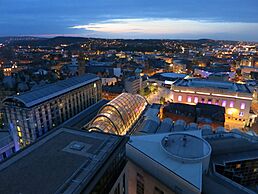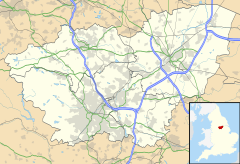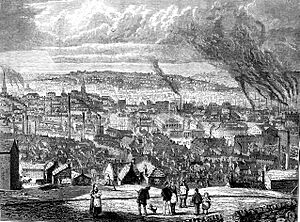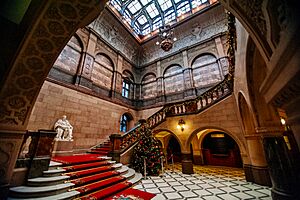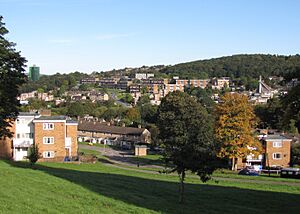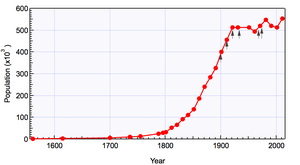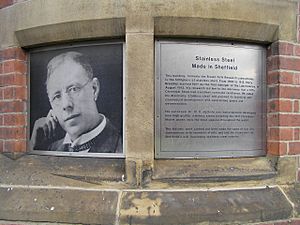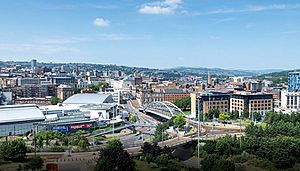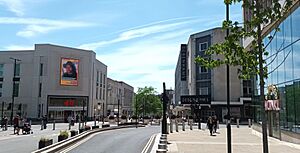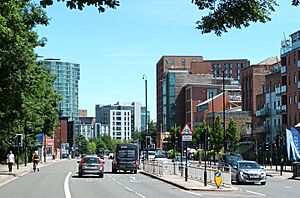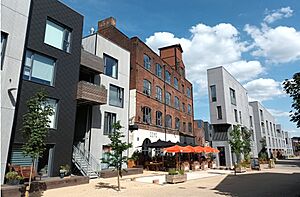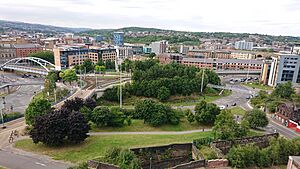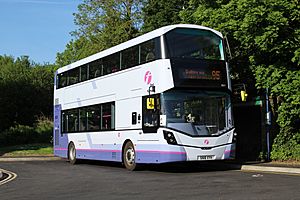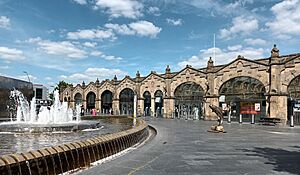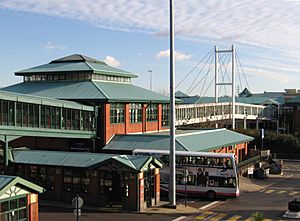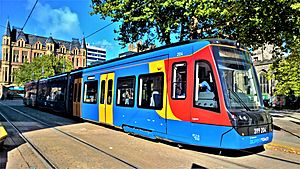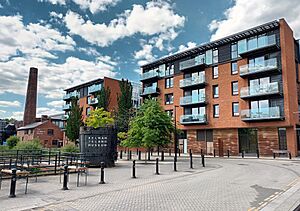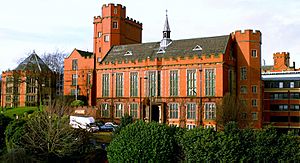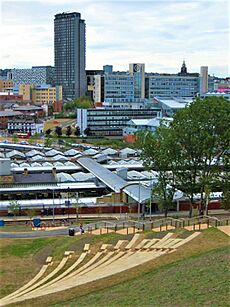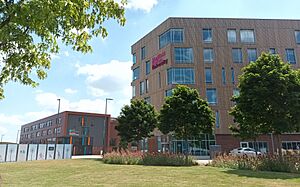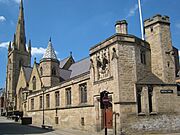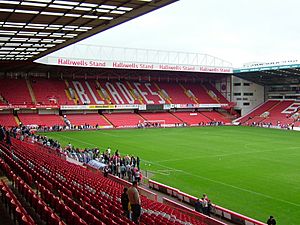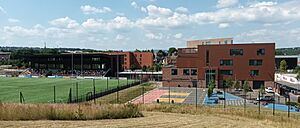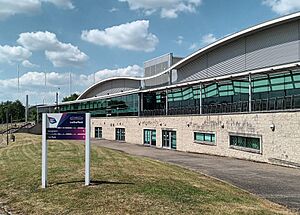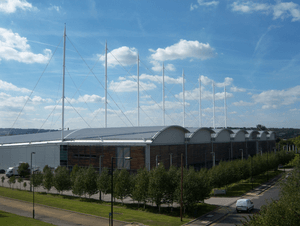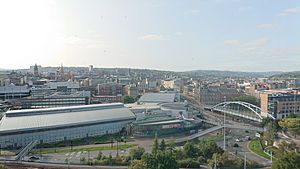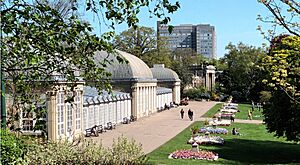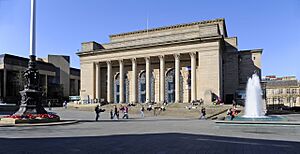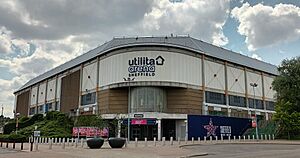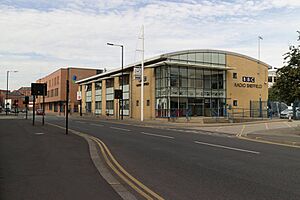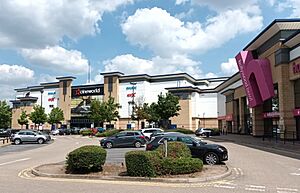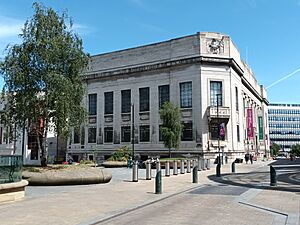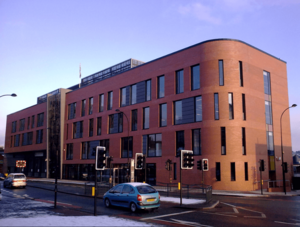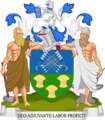Sheffield facts for kids
Quick facts for kids Sheffield |
|
|---|---|
| City | |
|
Central Sheffield skyline at night
Town Hall in the Peace Gardens
St Paul's Place
Sheffield City Hall on Barker's Pool
|
|
 Coat of arms |
|
| Area | 122.5 km2 (47.3 sq mi) |
| Population | 556,500 (2021 census) |
| • Density | 4,543/km2 (11,770/sq mi) |
| Demonym | Sheffielder |
| OS grid reference | SK355875 |
| Metropolitan borough |
|
| Metropolitan county | |
| Region | |
| Country | England |
| Sovereign state | United Kingdom |
| Post town | SHEFFIELD |
| Postcode district | S1-S17, S20, S35-36 |
| Dialling code | 0114 |
| Police | South Yorkshire |
| Fire | South Yorkshire |
| Ambulance | Yorkshire |
| EU Parliament | Yorkshire and the Humber |
| UK Parliament |
|
Sheffield is a big city in South Yorkshire, England. It's about 29 miles south of Leeds and 32 miles east of Manchester. The city gets its name from the River Sheaf that flows through it. Sheffield is the main hub of South Yorkshire.
The city sits on the eastern hills of the Pennines mountains. It's also in the valleys of the River Don and its four smaller rivers: the Loxley, Porter Brook, Rivelin, and Sheaf. A huge part of Sheffield, 61%, is green space. About a third of the city is even inside the Peak District national park. Sheffield is the fifth-largest city in England and has over 250 parks, woodlands, and gardens. It's thought to have around 4.5 million trees!
Sheffield was very important during the Industrial Revolution. Many new technologies were invented here. In the 1800s, the city's famous cutlery business grew a lot. New ways to make high-quality stainless steel and crucible steel were developed. This made the city's population grow almost ten times bigger! Sheffield became a city in 1893. After the 1970s, the steel and coal mining industries faced challenges. But in the 2000s, Sheffield has been rebuilt and improved, just like other British cities. The city's economy has grown a lot, showing it's a busy and developing place.
In 2021, Sheffield had about 556,500 people. This makes it the second-largest city in the Yorkshire and the Humber area. The wider Sheffield Built-up Area, which includes nearby Rotherham, has about 685,369 people. Sheffield is also part of the Core Cities Group, which includes eleven important British cities.
Sheffield has a long history with sports. It's home to the world's oldest football club, Sheffield F.C., and the oldest football ground, Sandygate. The two main professional football teams, Sheffield United and Sheffield Wednesday, play in what's called the Steel City derby. Sheffield also hosts the World Snooker Championship. The city is home to the Sheffield Steelers, the UK's first professional ice hockey team.
Contents
- What's in a Name? The Story of Sheffield
- Sheffield's Journey Through Time
- How Sheffield is Governed
- Sheffield's Landscape and Weather
- Who Lives in Sheffield? Demographics
- Sheffield's Economy: How People Make a Living
- Getting Around Sheffield: Transport Options
- Learning in Sheffield: Education and Museums
- Faith and Community: Religion in Sheffield
- Sports in Sheffield: A City of Champions
- Famous Places and Green Spaces
- Culture and Community: Sheffield's Lively Scene
- Public Services: Helping the Community
- Sheffield's Global Connections: International Relations
- Freedom of the City: Honoring Special People and Groups
- Images for kids
- See also
What's in a Name? The Story of Sheffield
The name Sheffield comes from Old English. It's named after the River Sheaf, a main river in the city. The word Sheaf might come from an old word meaning 'divide' or 'separation'. The second part of the name, 'field', means a clearing in a forest. So, the name probably means an old Anglo-Saxon settlement in a clearing where the River Don and River Sheaf meet. In old Latin, Sheffield was called Sefelda.
Sheffield's Journey Through Time
![]() Kingdom of England c. 12th century – 1707
Kingdom of England c. 12th century – 1707
![]() Kingdom of Great Britain 1707–1801
Kingdom of Great Britain 1707–1801
![]() United Kingdom of Great Britain and Ireland 1801–1922
United Kingdom of Great Britain and Ireland 1801–1922
![]() United Kingdom 1922–present
United Kingdom 1922–present
Early Days: From Ancient Times to Market Town
People have lived in the Sheffield area for a very long time, possibly since the late Upper Paleolithic period, about 12,800 years ago. The first signs of humans were found at Creswell Crags, east of the city. During the Iron Age, the Brigantes tribe lived here. They are thought to have built several hillforts around Sheffield.
After the Romans left, the Sheffield area might have been part of a British kingdom called Elmet. The rivers Sheaf and Don likely formed a border. Over time, Anglian settlers moved west. The towns that grew into Sheffield were founded by Anglo-Saxon and Danish people. In 829, a big event happened in Dore, now a part of Sheffield. The king of Northumbria, Eanred, gave up his power to Egbert of Wessex. This was a key step in uniting England.
After the Normans took over England, Sheffield Castle was built to protect the local areas. A small town grew around it, which is the heart of modern Sheffield. By 1296, a market was set up at what is now Castle Square. Sheffield then became a busy market town. In the 1300s, Sheffield was already known for making knives. This was even mentioned in Geoffrey Chaucer's The Canterbury Tales. By the early 1600s, it was the main place for making cutlery in England, besides London. From 1570 to 1584, Mary, Queen of Scots, was held prisoner in Sheffield Castle and Sheffield Manor.
The Industrial Revolution and Growth

In the 1740s, a new way to make high-quality steel was found. This was called the crucible steel process. Around the same time, a method to put a thin layer of silver onto copper was developed. This became known as Sheffield plate. These new ideas helped Sheffield grow into a big industrial town. However, losing some export markets caused a tough time in the late 1700s and early 1800s. This led to a cholera outbreak in 1832, which killed 402 people.
Sheffield's population grew very fast in the 1800s. It went from 60,095 people in 1801 to 451,195 by 1901. The Sheffield and Rotherham railway was built in 1838. Sheffield officially became a city in 1893. More people also meant more demand for water. New reservoirs were built outside the town.
In 1864, a dam wall broke, causing the Great Sheffield Flood. This flood killed 270 people and damaged many parts of the town. The growing population also led to many crowded homes. The pollution from factories was very bad. This made George Orwell write in 1937 that Sheffield was "architecturally a miserable disappointment".
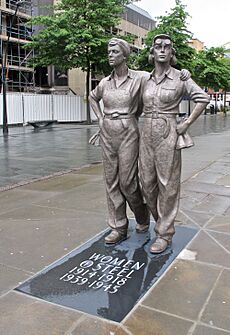
World War II and Beyond
The Great Depression hit Sheffield hard in the 1930s. But as World War II got closer, Sheffield's steel factories started making weapons and ammunition. This made the city a target for bombings. The worst bombings happened on December 12 and 15, 1940. This event is known as the Sheffield Blitz. Over 660 people died, and many buildings were destroyed. The Marples Hotel was directly hit, killing over 70 people.
Rebuilding Sheffield: Post-War Changes
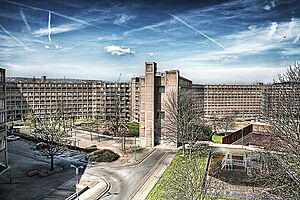
In the 1950s and 1960s, many old, crowded homes were pulled down. New housing projects like the Park Hill flats were built. Large parts of the city centre were also cleared for new roads. In 1962, the Great Sheffield Gale hit the city. Winds up to 97 miles per hour killed four people and damaged 150,000 houses.
More machines and competition from other countries led to many steel mills closing. The 1980s were a tough time for Sheffield's industries. The Meadowhall Centre, a big shopping mall, opened in 1990 on an old steelworks site. This created jobs but also made the city centre less busy. Sheffield started to rebuild when it hosted the 1991 World Student Games. New sports places like the Sheffield Arena, Don Valley Stadium, and Ponds Forge were built.
Sheffield in the 21st Century
Sheffield is changing quickly with new projects. The Heart of the City Project has improved many areas in the city centre. The Peace Gardens were updated in 1998. The Millennium Galleries opened in 2001, and the Winter Gardens opened in 2003. A new public space, the Millennium Square, opened in 2006 to connect these areas. Other improvements include Sheaf Square near the railway station. It has a sculpture called "The Cutting Edge," made from Sheffield steel.
Sheffield was hit hard by floods in 2007 and 2019. Many famous buildings like Meadowhall and Hillsborough Stadium flooded because they are near rivers. The city council has been working to prevent future floods.
Between 2014 and 2018, there were disagreements about cutting down trees along the city's roads. About 4,000 trees were cut down as part of a road maintenance plan. This led to protests and arrests. The protests stopped in 2018 when the council changed its approach to managing street trees.
In 2022, Sheffield was named a "Tree City of the World". This was for its efforts to manage urban forests. However, a report later criticized the council for cutting down many healthy trees. The council apologized for its mistakes.
How Sheffield is Governed
Local Government: Running the City
Sheffield is run by the Sheffield City Council. Councillor Tom Hunt became the leader in May 2023. The council has 84 councillors who represent 28 different areas, called wards. Each ward has three councillors. After the 2024 local elections, the Labour has 36 seats, Liberal Democrats have 27, the Green Party has 14, and there are 7 Independent councillors.
The city also has a Lord Mayor. This is mostly a ceremonial role now, but it used to have a lot of power. The Lord Mayor is chosen every year.
For a long time, the Labour Party controlled the council. It was known for its leftist ideas. In the 1980s, when David Blunkett led the council, the area was even called the "Socialist Republic of South Yorkshire". However, the Liberal Democrats controlled the council from 1999 to 2001, and again from 2008 to 2011.
Many council-owned places are run by special trusts. Sheffield International Venues manages sports and leisure facilities like Sheffield Arena. Museums Sheffield and the Sheffield Industrial Museums Trust look after the city's galleries and museums.
Working Together: South Yorkshire's Combined Authority
Sheffield is part of the larger South Yorkshire Mayoral Combined Authority. This group is led by Mayor Oliver Coppard since 2022. It covers the area that used to be the South Yorkshire County Council from 1974 to 1986.
In 2004, a plan called Moving Forward: The Northern Way created city regions. These became independent groups in 2011. The Sheffield City Region group includes the South Yorkshire authorities and other nearby councils. In 2014, the Sheffield City Region Combined Authority was formed. In 2020, it changed to its current name.
Who Represents Sheffield in Parliament?
Sheffield sends five members of parliament (MPs) to the House of Commons. A sixth MP, for Penistone and Stocksbridge, represents parts of Sheffield and Barnsley. Nick Clegg, a former Deputy Prime Minister, was an MP for Sheffield Hallam from 2005 to 2017. In 2017, the seat elected a Labour MP for the first time.
Sheffield's Landscape and Weather
Sheffield is located at 53.38297°N 1.4659°W. It's right next to Rotherham, mostly separated by the M1 motorway. Barnsley also borders Sheffield to the north. The southern and western edges of the city meet Derbyshire. In the early 1900s, Sheffield expanded into Derbyshire, taking in villages like Totley and Dore.
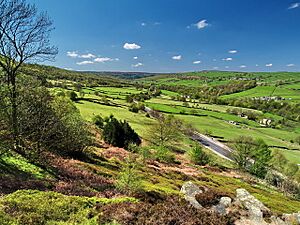
Sheffield has a very varied landscape. It sits on the eastern hills of the Pennines. To the west are the main uplands and the Peak District National Park. To the east is the lower South Yorkshire Coalfield. Five rivers meet in Sheffield: Don, Sheaf, Rivelin, Loxley, and Porter. Because of this, much of the city is built on hillsides. You can often see great views of the city centre or the countryside. Blake Street is one of England's steepest residential streets.
The highest point in Sheffield is 548 metres (1,798 ft) near High Stones. The lowest point is just 29 metres (95 ft) above sea level near Blackburn Meadows. Most houses are between 100 and 200 metres (330 and 660 ft) above sea level. The highest residential street is Redmires Lane at 302 metres (991 ft). People often say Sheffield was built on "Seven Hills," like Rome, but this is probably a joke.
Sheffield is thought to have about 4.5 million trees. This makes it one of the greenest cities in Europe and the UK. It even won the 2005 Entente Florale competition for its greenery. The city has over 250 parks, woodlands, and gardens. There are more than 170 woodlands and 78 public parks. This means 61% of the city is green space. Sheffield also has many different types of habitats, like urban areas, parkland, woodlands, farms, moors, and rivers. Six areas in the city are special scientific interest sites.
The city's current boundaries were set in 1974. They include a large part of the countryside around the main city area. About a third of Sheffield is inside the Peak District National Park. No other English city had parts of a national park within its borders until 2010.
 |
Huddersfield, Penistone | Barnsley, Leeds, Wakefield | Rotherham, Doncaster |  |
| Manchester, Glossop | Worksop, Retford, Lincoln | |||
| Buxton, Bakewell, Matlock | Chesterfield, Dronfield, Derby | Mansfield, Newark, Nottingham |
Sheffield's Climate: Weather Patterns
Sheffield has a temperate oceanic climate, like the rest of the UK. The Pennines mountains to the west can make it cool, cloudy, and wet. But they also protect the city from strong westerly winds. Between 1971 and 2000, Sheffield got about 824.7 mm (32.47 in) of rain each year. December was the wettest month, and July was the driest. July was also the hottest month, with an average high of 20.8°C (69.4°F). The highest temperature ever recorded in Sheffield was 39.4°C (102.9°F) on July 19, 2022.
The average low temperature in January and February is 1.6°C (34.9°F). The coldest temperature ever recorded at Weston Park since 1882 was -14.6°C (5.7°F) in February 1895. On average, there are 67 days with ground frost during the winter months.
| Climate data for Sheffield (Weston Park) WMO ID: 99107; coordinates 53°22′53″N 1°29′29″W / 53.38139°N 1.49137°W; elevation: 131 m (430 ft); 1991–2020 normals, extremes 1882–present |
|||||||||||||
|---|---|---|---|---|---|---|---|---|---|---|---|---|---|
| Month | Jan | Feb | Mar | Apr | May | Jun | Jul | Aug | Sep | Oct | Nov | Dec | Year |
| Record high °C (°F) | 15.9 (60.6) |
18.2 (64.8) |
23.3 (73.9) |
26.4 (79.5) |
28.9 (84.0) |
30.7 (87.3) |
39.4 (102.9) |
34.3 (93.7) |
32.9 (91.2) |
25.7 (78.3) |
18.9 (66.0) |
17.6 (63.7) |
39.4 (102.9) |
| Mean daily maximum °C (°F) | 7.0 (44.6) |
7.7 (45.9) |
10.0 (50.0) |
13.1 (55.6) |
16.4 (61.5) |
19.2 (66.6) |
21.4 (70.5) |
20.8 (69.4) |
17.9 (64.2) |
13.7 (56.7) |
9.8 (49.6) |
7.3 (45.1) |
13.7 (56.7) |
| Daily mean °C (°F) | 4.6 (40.3) |
4.9 (40.8) |
6.7 (44.1) |
9.2 (48.6) |
12.1 (53.8) |
15.0 (59.0) |
17.1 (62.8) |
16.7 (62.1) |
14.2 (57.6) |
10.7 (51.3) |
7.3 (45.1) |
5.0 (41.0) |
10.3 (50.5) |
| Mean daily minimum °C (°F) | 2.2 (36.0) |
2.2 (36.0) |
3.4 (38.1) |
5.2 (41.4) |
7.8 (46.0) |
10.8 (51.4) |
12.8 (55.0) |
12.6 (54.7) |
10.5 (50.9) |
7.8 (46.0) |
4.8 (40.6) |
2.6 (36.7) |
6.9 (44.4) |
| Record low °C (°F) | −13.3 (8.1) |
−14.6 (5.7) |
−9.4 (15.1) |
−7.8 (18.0) |
−0.7 (30.7) |
1.4 (34.5) |
3.5 (38.3) |
4.1 (39.4) |
1.7 (35.1) |
−4.1 (24.6) |
−7.2 (19.0) |
−10.0 (14.0) |
−14.6 (5.7) |
| Average precipitation mm (inches) | 75.7 (2.98) |
67.0 (2.64) |
59.5 (2.34) |
58.8 (2.31) |
54.5 (2.15) |
75.1 (2.96) |
62.2 (2.45) |
65.1 (2.56) |
63.5 (2.50) |
78.7 (3.10) |
84.7 (3.33) |
86.9 (3.42) |
831.6 (32.74) |
| Average rainy days (≥ 1.0 mm) | 13.2 | 11.5 | 11.1 | 10.1 | 9.3 | 9.5 | 9.4 | 10.0 | 9.3 | 12.7 | 13.3 | 13.7 | 133.1 |
| Mean monthly sunshine hours | 50.1 | 76.8 | 121.0 | 153.2 | 198.2 | 181.0 | 180.7 | 181.3 | 138.2 | 97.0 | 59.4 | 48.3 | 1,485.2 |
| Average ultraviolet index | 0 | 1 | 2 | 4 | 5 | 6 | 6 | 5 | 4 | 2 | 1 | 0 | 3 |
| Source 1: Met Office | |||||||||||||
| Source 2: KNMI, WeatherAtlas and Meteo Climat | |||||||||||||
The Weston Park Weather station has been recording weather since 1882. A report in 2008 showed that Sheffield's climate is getting warmer faster than before. 1990 and 2006 were the hottest years on record. Sheffield has also worked to reduce its carbon footprint.
Green Belt: Protecting Nature Around Sheffield
Sheffield is surrounded by a green belt area. This is a protected zone that stops the city from spreading too much. It helps keep the towns and areas around Sheffield from merging together. It also protects the countryside and encourages building on old industrial sites. This means there are strict rules about new buildings in these areas. The green belt also helps people enjoy nature, with many parks and trails.
Sheffield's Neighbourhoods: How the City is Divided
Sheffield is made up of many suburbs and neighbourhoods. Many of these used to be small villages that became part of Sheffield as it grew. Today, the city is divided into 28 electoral wards. Each ward usually covers 4–6 areas and has three councillors. These wards are grouped into six parliamentary constituencies. Most of Sheffield doesn't have local parish councils, but Bradfield and Ecclesfield do. Stocksbridge also has its own town council.
Who Lives in Sheffield? Demographics
| Population Change | ||
|---|---|---|
| Year | Pop. | ±% |
| 1801 | 60,095 | — |
| 1821 | 84,540 | +40.7% |
| 1841 | 134,599 | +59.2% |
| 1861 | 219,634 | +63.2% |
| 1881 | 335,953 | +53.0% |
| 1901 | 451,195 | +34.3% |
| 1921 | 543,336 | +20.4% |
| 1941 | 569,884 | +4.9% |
| 1951 | 577,050 | +1.3% |
| 1961 | 574,915 | −0.4% |
| 1971 | 572,794 | −0.4% |
| 1981 | 530,844 | −7.3% |
| 1991 | 528,708 | −0.4% |
| 2001 | 513,234 | −2.9% |
| 2011 | 551,800 | +7.5% |
| 2019 | 584,028 | +5.8% |
In 2001, Sheffield had 513,234 people living there. This was a small drop from 1991. The wider Sheffield urban area had 640,720 people. In 2011, most of Sheffield's population (84%) was White. There were also people of mixed race (2.4%), Asian (8%), Black (3.6%), and Arab (1.5%) backgrounds.
Most people (53%) in Sheffield are Christian. About 6% are Muslim, and 31% say they have no religion. The largest age group is 20- to 24-year-olds (9%). This is because of the large number of university students.
The Industrial Revolution caused a big increase in Sheffield's population. Many people moved to the city as the cutlery and steel industries grew. The population kept growing until the mid-1900s. Then, as industries declined, the population started to shrink. However, in the early 2000s, the population began to grow again.
Sheffield's population was highest in 1951, with 577,050 people. Since then, it has slowly gone down. But in mid-2007, the population was estimated at 530,300, which was an increase of about 17,000 people since 2001.
Even though it's a city, Sheffield is sometimes called "the largest village in England". This is because it's quite isolated by hills. Also, its population has been stable, and people don't move away as much as in some other cities. The land around Sheffield wasn't good for industry, and now it has protected green areas. These natural features have kept the city from spreading too much.
Sheffield's Economy: How People Make a Living
| Jobs | Number | % |
|---|---|---|
| Total employee jobs | 255,700 | N/A |
| Full-time | 168,000 | 65.7% |
| Part-time | 87,700 | 34.3% |
| Manufact. & Construct. | 40,300 | 15.7% |
| Manufacturing | 31,800 | 12.4% |
| Construction | 8,500 | 3.3% |
| Services | 214,900 | 84.1% |
| Distribution, hotels & restaurants | 58,800 | 23.0% |
| Transport & communications | 14,200 | 5.5% |
| Finance, IT, other business activities | 51,800 | 20.2% |
| Public admin, education & health | 77,500 | 30.3% |
| Other services | 12,700 | 5.0% |
| Tourism-related | 18,400 | 7.2% |

After a tough period, Sheffield's economy is growing strong again. A study in 2004 showed that the Hallam area of Sheffield was one of the wealthiest places outside London. Many new buildings are being built, like the City Lofts Tower and St Paul's Place. The Winter Gardens, Peace Gardens, and Millennium Galleries are also part of this growth. Sheffield's economy grew from £5.6 billion in 1997 to £9.2 billion in 2007.
In 2008, Sheffield was named one of the top ten "best cities to locate a business today." It was ranked third for being "greenest" and second for financial help available to businesses.
Steel City: Sheffield's Industrial Heart
Sheffield is famous worldwide for making metal and steel. The first official record of cutlery making in Sheffield was in 1297. Sheffield was good at making cutlery because it had many streams for water power. It also had the right type of stones for grinding wheels. In the 1600s, the Company of Cutlers in Hallamshire was set up. This group helped Sheffield become known for its cutlery, first in England, then around the world.
Sheffield was a key player in the Industrial Revolution. It became a powerful industrial city in the 1700s and was called "Steel City". Many new ideas in metalworking came from Sheffield. For example, Benjamin Huntsman discovered the crucible technique in the 1740s. This method was later replaced by Henry Bessemer's invention in 1856. Thomas Boulsover invented Sheffield plate (silver-plated copper) in the early 1700s.
Stainless steel was invented by Harry Brearley in 1912. This made affordable cutlery available to everyone. Later, in the 1960s, 70s, and 80s, F. B. Pickering and T. Gladman helped develop strong, modern steels. New manufacturing technologies are still being created at the Advanced Manufacturing Park. This park is a partnership between the Boeing Company and the University of Sheffield. Other big companies like Rolls-Royce plc and McLaren Automotive are also there.
Forgemasters, started in 1805, is the only independent steel works left in the world. It's known for making huge and complex steel parts. It can even make parts for nuclear submarines. In 2021, the UK Ministry of Defence bought Forgemasters. They plan to invest £400 million to help it grow. This is because Forgemasters is very important for building the UK's nuclear submarine fleet.
Besides iron and steel, coal mining was also a big industry in Sheffield. The Palace of Westminster in London was even built using limestone from quarries near Sheffield.
Public Services: Jobs in the Community
Sheffield has many jobs in the public sector, with 77,500 workers. Between 1995 and 2008, the number of jobs in the city grew by 22%. Half of these new jobs were in the public sector. Big public sector employers include the National Health Service, The University of Sheffield, and Sheffield Hallam University. Many government departments also have offices here.
Sheffield City Council is also a major public sector employer. It employs over 8,000 people in different areas. The council also manages all state schools and their staff. To provide public services, the council works with private companies like Amey, Veolia, and Capita. These companies also create jobs in the city.
Shopping and Fun: Leisure and Retail in Sheffield
City Centre Shopping: What to Find Downtown
Sheffield is a big shopping hub. It has many well-known stores and designer shops. The main shopping areas in the city centre are The Moor, Fargate, Orchard Square, and the Devonshire Quarter. Big department stores like Marks and Spencer are here. Sheffield's main market, Sheffield Moor Market, opened in 2013. It has 196 stalls with local produce and international food.
In March 2021, the John Lewis store in Sheffield announced it would close. This was due to fewer sales and more people shopping online, especially during the COVID-19 pandemic.
To make the city centre better, new projects are happening. These include Leopold Square, The Moor, and St Paul's Place. The Heart of the City projects are also improving the area. In March 2022, Sheffield City Council announced a new leisure hub for Fargate. It will have cafes, shops, and big screens for sports.
Shopping Centres: Big Malls Around Town
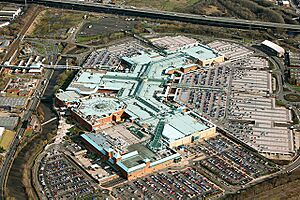
Meadowhall is a huge shopping centre northeast of Sheffield, near the M1 motorway. It's one of the largest in the UK, with 1.5 million square feet of shops. Over 30 million people visit Meadowhall each year. It has 270 shops, 37 restaurants, and a cinema. Many famous brands are here. You can get to Meadowhall from the city centre by train, Supertram, or bus. Meadowhall opened in 1990 on the site of an old steelworks. This helped bring new life to the Lower Don Valley area.
Next to Meadowhall is Meadowhall Retail Park, with more shops and food places. The Sheffield IKEA store opened here in 2017. It was the 20th IKEA in the UK and created 480 new jobs.
The second-largest shopping centre in Sheffield is Crystal Peaks. It's in the southeast of the city, next to Drakehouse Retail Park. Both opened in 1988 and get about 11 million visitors a year. Crystal Peaks has 101 shops and eateries. It also has a transport hub for buses.
Local Shopping: Exploring Sheffield's Suburbs
Beyond the city centre, there are other fun places to shop and relax. Ecclesall Road in the southwest is a main street with bars, restaurants, and cafes. Many students live here because Sheffield Hallam University is nearby. London Road in the south is known for its many international restaurants. Broomhill in the west is another student area. In the northwest, Hillsborough is a big shopping and sports area. Stocksbridge Fox Valley is a new shopping and leisure centre built on an old industrial site.
In recent years, the Kelham Island Quarter north of the city centre has become very popular. It's known for its unique cafes, restaurants, and pubs. Many new homes have also been built there.
Tourism: What to See and Do
Tourism is a big part of Sheffield's economy. People visit for the Peak District, sports events like the Snooker World Championships, and music festivals like Tramlines. In 2019, tourism brought £1.36 billion to Sheffield and supported 15,000 jobs.
Getting Around Sheffield: Transport Options
Driving, Buses, and Bikes
Major motorways near Sheffield are the M1 and M18. The Sheffield Parkway connects the city centre to these motorways. The M1 goes around the northeast of the city. The M18 branches off the M1 and links Sheffield with Doncaster.
The A57 and A61 road are the main roads through Sheffield. They cross in the city centre. An inner ring road helps traffic avoid the city centre. An outer ring road runs closer to the city's edge.
Sheffield Interchange is the main bus station. Other bus stations are at Halfway, Hillsborough, and Meadowhall. Many companies run bus services, with First South Yorkshire being the largest. There's also a special bus route between Sheffield and Maltby via Rotherham.
Coach services are run by National Express and Megabus. They stop at Sheffield Interchange and Meadowhall. You can get direct coaches to London and airports like Manchester Airport and Heathrow/Gatwick Airports.
Even though Sheffield is hilly, it's a good city for cycling. It's part of the Trans-Pennine Trail, a national cycle route. There are many cycle paths in the woods and more cycle lanes in the city.
Trams, Trains, and Tram-Trains
Train services in Sheffield are run by several companies. Major train routes through Sheffield station connect to London, Scotland, and southwest England. With the new London St Pancras station, Sheffield has a direct link to Europe via Eurostar.
There are also local train routes connecting Sheffield to other parts of South Yorkshire, West Yorkshire, and Derbyshire. These include the Penistone Line and the Hope Valley Line. Besides the main stations, there are smaller stations in areas like Chapeltown and Dore & Totley.
The Sheffield Supertram opened in 1994. It has 37 miles of track and four lines that all go through the city centre. The Black Line, which opened in 2018, uses tram-trains. These are special trams that can also run on regular train tracks between Sheffield and Rotherham. In March 2024, the South Yorkshire Combined Mayoral Authority took over control of the tram network.
Canals: Waterways for Transport
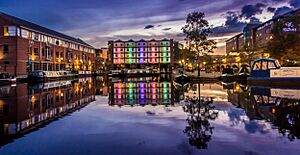
The Sheffield & South Yorkshire Navigation (S&SY) is a system of canals and rivers. It runs for 43 miles and has 29 locks. It connects Sheffield, Rotherham, and Doncaster to the River Trent. The canal ends at Victoria Quays in Sheffield City Centre.
Air Travel: Airports Near Sheffield
The closest airports are in Leeds Bradford, Humberside, and East Midlands. Manchester also has hourly direct train services.
Sheffield used to have its own airport, Sheffield City Airport, which opened in 1997. It was a small airport for short business flights. But it closed in 2008 because low-cost airlines became popular.
Doncaster Sheffield Airport was then the closest international airport, about 18 miles from the city centre. It opened in 2005 and served charter and budget airlines. A new road, the Great Yorkshire Way, connected it to the M18 motorway. However, the airport closed in 2022.
Learning in Sheffield: Education and Museums
Sheffield has two universities, 141 primary schools, and 28 secondary schools.
Museums: Exploring Sheffield's Past
Sheffield's museums are managed by two groups. Museums Sheffield runs the Weston Park Museum, Millennium Galleries, and Graves Art Gallery. These are some of the oldest museums in the city. The Millennium Galleries are newer and connect to the Winter Garden. These museums show Sheffield's history and other topics, sometimes with exhibits from other big galleries.
The Sheffield Industrial Museums Trust manages museums about Sheffield's industrial past. There are three of these. Kelham Island Museum is on the site of an old iron foundry. It shows the city's steel-making history. It has a Bessemer converter and parts from World War II aircraft. It's also an important stop on the European Route of Industrial Heritage. Abbeydale Industrial Hamlet and Shepherd Wheel are also old industrial sites that are now museums.
In August 2022, the Yorkshire Natural History Museum opened in Sheffield. It has a collection of Jurassic marine life fossils. It also has Europe's first public fossil preparation lab. On opening day, a palaeontologist found the oldest vertebrate embryo in Britain there.
Other independent museums include the National Videogame Museum and the National Emergency Services Museum. The University of Sheffield also has the Turner Museum of Glass.
Universities and Colleges: Higher Education
Sheffield has two universities: the University of Sheffield and Sheffield Hallam University. Together, they bring about 60,000 students to the city each year. The University of Sheffield is the older one, started in 1897. It's one of the original red brick universities and part of the Russell Group.
Sheffield Hallam University (SHU) has two campuses. The City Campus is in the city centre. The Collegiate Crescent Campus is near Ecclesall Road. SHU started in 1843 as the Sheffield School of Design. It became a university in 1992.
Sheffield also has three main further education colleges: The Sheffield College, Longley Park Sixth Form, and Chapeltown Academy. The Sheffield College was formed by merging six smaller colleges.
The University Technical College (UTC) program started in 2010. It helps students aged 14 to 18 learn about STEM subjects (Science, Technology, Engineering, and Maths). Sheffield has two UTCs: UTC Sheffield City Centre and UTC Sheffield Olympic Legacy Park. These UTCs are supported by Sheffield Hallam University. They are like regular secondary schools but focus more on STEM.
Schools: Primary and Secondary Education
Sheffield has 137 primary schools and 26 secondary schools. Ten of the secondary schools have sixth forms for older students. There are also five independent private schools, like Birkdale School and Sheffield High School. The city also has 12 special schools. All schools are open to both boys and girls. Sheffield City Council manages 32 nurseries and children's centres.
Faith and Community: Religion in Sheffield
Sheffield is a diverse city with many different cultures and places of worship. The main Church of England church is Sheffield Cathedral on Church Street. The Roman Catholic church is St Marie's Cathedral on Norfolk Row.
Other churches include St Vincent's Church and St Matthew's Church. There are also other places of worship like the Madina Mosque and the Kingfield Synagogue.
-
Sheffield Cathedral, one of the oldest churches in the city.
Sports in Sheffield: A City of Champions
Football: The Beautiful Game in Sheffield
Sheffield has a long history with sports. It claims to be where professional association football began. In 1857, cricketers formed the world's first official football club, Sheffield F.C.. The second oldest, Hallam F.C., plays at the world's oldest football ground. These two clubs play in the Sheffield derby. By 1860, there were 15 football clubs in Sheffield.
Sheffield is best known for its two professional football teams: Sheffield United, called The Blades, and Sheffield Wednesday, called The Owls. United plays at Bramall Lane, and Wednesday plays at Hillsborough. Both teams play in the EFL Championship. The Steel City Derby between them is one of the most intense football rivalries in England.
Before World War II, both Wednesday and United were very successful. Sheffield Wednesday won the Football League four times. Sheffield United won it once. In the 1970s and 1980s, both teams struggled. Wednesday won the League Cup in 1991. Both clubs were founding members of the Premier League in 1992. United was promoted to the Premier League in 2019 and did very well in the 2019–20 season. However, they were relegated in the 2020–21 season.
Sheffield was the site of a terrible sports disaster in 1989. The Hillsborough disaster killed 97 Liverpool fans during an FA Cup semi-final.
Rotherham United also played in Sheffield for a few years. There are also places for golf, climbing, and bowling. The city has a new national ice-skating arena called IceSheffield.
Rugby: Sheffield Eagles on the Field
The Sheffield Eagles RLFC are the city's professional rugby league team. They play at Sheffield Olympic Legacy Stadium. They won back-to-back titles in 2012 and 2013. Their biggest win was in 1998 when they beat Wigan in the Challenge Cup final.
Other Sports: A Wide Range of Activities
Sheffield has several field hockey clubs. The Sheffield Giants are an American football team that plays in the top British league.
Sheffield is home to the Sheffield Steelers professional ice hockey team. They play at the Sheffield Arena, which holds 9,300 people. They are one of the best teams in the UK and often sell out the arena. The National Hockey League's Stanley Cup was even made in Sheffield in 1892. Sheffield also has the Sheffield Steel Rollergirls, a roller derby team.
Sports Facilities and Events: Where the Action Happens
Many of Sheffield's sports facilities were built for the World Student Games in 1991. These include Sheffield Arena and the Ponds Forge diving and swimming complex. Ponds Forge is also home to the Sheffield City Swimming Club. The former Don Valley International Athletics Stadium was also built for these games.
After Don Valley Stadium closed in 2013, the Sheffield Olympic Legacy Park was built on the same site. This park is a project involving Sheffield's universities, the English Institute of Sport, and medical companies. It includes teaching facilities, a stadium, and research centres.
The Sheffield Ski Village was Europe's largest artificial ski resort before it was destroyed by fires. Sheffield also has six indoor climbing centres. It was the UK's first National City of Sport. It is home to the English Institute of Sport – Sheffield, where British athletes trained for the 2012 Olympics.
Sheffield is closely linked with snooker. The city's Crucible Theatre hosts the World Snooker Championships. The English Institute of Sport hosts many top fencing competitions. The English squash open is also held here. Sheffield has rugby union, basketball, hockey, ice hockey, and speedway teams. There are also many golf courses.
Sheffield was a candidate city to host matches for the English 2018 and 2022 FIFA World Cup bid. The Hillsborough Stadium was chosen as the proposed venue. However, the bid was not successful.
Sheffield hosted the end of Stage 2 of the 2014 Tour de France cycling race. The Sheffield Half Marathon is held every year with thousands of participants.
Famous Places and Green Spaces
Weston Park Museum tells the stories of Sheffield and its people. The museum first opened in 1875.
Bishops' House was built in 1500 and is now a museum.
The Sheffield Walk of Fame in the city centre honors famous people from Sheffield. It's like the Hollywood version. Sheffield also used to have its own Ferris Wheel, the Wheel of Sheffield, but it was moved to London.
Heeley City Farm and Graves Park have farm animals that are open to the public. Sheffield also has a zoo, the Tropical Butterfly House, Wildlife & Falconry Centre.
There are about 1,100 listed buildings in Sheffield. Only five of these are Grade I listed, which is the highest level. In 1959, an architecture historian said the city was "architecturally a miserable disappointment." But in 2007, Sheffield's Peace and Winter Gardens won an award for being a "Great Place." In 2016, a public art event called the Herd of Sheffield raised £410,000 for the Sheffield Children's Hospital.
Green Spaces: Parks and Gardens
Sheffield is known for its many trees, estimated at 4.5 million. It's one of the greenest cities in England. There are over 250 parks, woodlands, and gardens. This includes 78 public parks and 10 public gardens.
The Sheffield Botanical Gardens are on a 19-acre site and date back to 1836. They have a large, old Victorian glasshouse. The Peace Gardens, next to the Town Hall, are in the city centre. They are famous for their water features, especially the Goodwin Fountain. The Winter Garden is a large glasshouse with about 2,500 plants from around the world.
Sheffield also has many nature reserves and 170 woodland areas. About 80 of these woodlands are very old.
The southwest edge of the city is part of the Peak District National Park. This was England's first national park, started in 1951.
Sheffield City Council has created a new chain of parks called Sheaf Valley Park. It has an outdoor amphitheatre and will include an arboretum. This area used to be a medieval deer park.
Theatres: Live Shows and Performances
Sheffield has two large theatres: the Lyceum Theatre and the Crucible Theatre. With the smaller Studio Theatre, they form the largest theatre complex outside London. The Crucible Theatre has hosted the World Snooker Championships since 1977. It also puts on many famous plays and shows. The Lyceum, opened in 1897, hosts touring shows and operas. Sheffield also has the Montgomery Theatre, a smaller theatre near the town hall. There are many other small amateur theatres in the city.
Culture and Community: Sheffield's Lively Scene
Sheffield was considered for the first UK City of Culture title, but Derry was chosen in 2010.
Sheffield has many pubs and lively areas. West Street in the city centre has many pubs, bars, and clubs, popular with students. Newer areas like Leopold Square and Millennium Square have restaurants with food from around the world.
Sheffield was home to important nightclubs in the early dance music scene. Gatecrasher One was very popular until it was destroyed by fire in 2007.
The city has a strong poetry and spoken word scene. There are many events and groups for writers.
Sheffield has thirteen morris dance teams, which is one of the highest numbers in the country. Almost all types of this traditional dance are performed here.
Sheffield hosts several festivals, including the Festival of Debate, the Grin Up North Sheffield Comedy Festival, the Sensoria Music & Film Festival, and the Tramlines Festival.
Music: Sheffield's Sound
The Tramlines Festival started in 2009. It's an annual music festival held at Hillsborough Park and other venues in Sheffield City Centre. It features local and national artists.
Many famous music acts come from Sheffield, including Joe Cocker, Def Leppard, Arctic Monkeys, Bring Me the Horizon, Pulp, and Moloko. The indie band the Long Blondes also started here.
Sheffield has been home to many synth-pop and electronic bands. These include the Human League, Heaven 17, and ABC. The techno label Warp Records started here and is now a well-known dance music label. More recently, other electronic music styles like bassline house began in Sheffield.
In 1999, the National Centre for Popular Music opened. It was a museum about popular music. It later became a live music venue and then the students' union for Sheffield Hallam University. Live music venues in the city include Leadmill, the City Hall, and the O2 Academy Sheffield.
The city has several orchestras and choirs, like the Sheffield Symphony Orchestra and the Sheffield Philharmonic Chorus. It's also home to Music in the Round, which promotes chamber music.
Sheffield has a strong folk music community. Singing and music sessions happen weekly in pubs. The city also hosts the annual Sheffield Sessions Festival. The tradition of singing carols in pubs around Christmas is still alive here. These "Sheffield Carols" are very old and have unique words.
Sheffield was considered to host the 2023 Eurovision Song Contest, but Liverpool was chosen.
Media: News and Entertainment
Sheffield has two local newspapers: The Star and Sheffield Telegraph. The Star has been published daily since 1897. The Sheffield Telegraph is now a weekly paper.
Sheffield has its own TV station, Sheffield Live TV. Regional broadcasters BBC Yorkshire and Yorkshire Television also cover the city.
Local radio stations include BBC Radio Sheffield and Hits Radio South Yorkshire (formerly Hallam FM). There are also community radio stations like Sheffield Live.
Film: Sheffield on the Big Screen
Many films and plays are set in Sheffield, such as The Full Monty, Threads, and Four Lions. Parts of other films like F.I.S.T. and The Princess Bride were filmed here. The Sheffield Doc/Fest documentary festival is held every year at the Showroom Cinema. In 2007, Sheffield hosted the Awards of the International Indian Film Academy. The 2018 series of Doctor Who featured the Park Hill estate and other Sheffield locations. A follow-up series to The Full Monty was also filmed in Sheffield. Scenes for the HBO miniseries The Regime, starring Kate Winslet, were filmed in Sheffield.
Valley Centertainment in the Lower Don Valley is a big leisure complex. It has a 20-screen Cineworld cinema, which is the largest in the chain. It also has a bowling alley and restaurants. Sheffield has six other cinemas. The Showroom is an independent cinema that shows non-mainstream films.
Public Services: Helping the Community
Sheffield is policed by South Yorkshire Police. Their headquarters are in the city. Sheffield is one of their four main areas.
Medical services in Sheffield are provided by three NHS Foundation Trusts:
- Sheffield Teaching Hospitals NHS Foundation Trust
- Sheffield Children's NHS Foundation Trust
- Sheffield Health and Social Care NHS Foundation Trust
Sheffield Teaching Hospitals NHS Foundation Trust provides healthcare for adults. It also trains medical students from the University of Sheffield. It has two main sites: the Royal Hallamshire Hospital and the Northern General Hospital. Sheffield Children's NHS Foundation Trust provides healthcare for children.
Ambulances are provided by the Yorkshire Ambulance Service. Fire services are provided by South Yorkshire Fire and Rescue Service.
Sheffield City Council runs fifteen libraries in the city. Sixteen more are run by community groups. The largest is Sheffield Central Library, which also has the Local Studies Library with items about local history.
Waste services in Sheffield are provided by Veolia Environmental Services. Council buildings are maintained by Kier Group Sheffield.
Sheffield has a special energy system that uses the city's waste. It burns the waste to create electricity and hot water. This hot water is sent through pipes to many buildings in the city, including cinemas, hospitals, shops, offices, and universities. This system produces 60 megawatts of heat and up to 19 megawatts of electricity from 225,000 tonnes of waste.
Sheffield's Global Connections: International Relations
The Sheffield International Linking Committee helps connect Sheffield with other places around the world. It has six sister cities:
- Chengdu, Sichuan, China
- Anshan, Liaoning, China
- Bochum, North Rhine-Westphalia, Germany
- Donetsk, Donetsk Oblast, Ukraine
- Estelí, Estelí Department, Nicaragua
- Khmelnytskyi, Khmelnytskyi Oblast, Ukraine
Four other cities have a Friendship Agreement with Sheffield:
- Kawasaki, Kanagawa, Japan
- Kitwe, Copperbelt Province, Zambia
- Kotli, Pakistan-administered Kashmir
- Pittsburgh, Pennsylvania, United States – These two cities are linked because both are known for making steel, earning them the nickname "Steel City".
Two roads in Sheffield are named after sister cities: Bochum Parkway and Donetsk Way. In Bochum, Germany, there is also a major road called the Sheffield-Ring.
Freedom of the City: Honoring Special People and Groups
The following people and military units have been given the Freedom of the City of Sheffield. This is a special honor.
Individuals Honored
- Henry Fitzalan-Howard, 15th Duke of Norfolk: 25 October 1899.
- Sir Frederick Mappin: 25 October 1899.
- Sir Henry Stephenson: 25 October 1899.
- Field Marshal 1st Earl Kitchener of Khartoum: 13 August 1902.
- Sir Marcus Samuel: 10 June 1903.
- William Morris Hughes: 26 May 1916.
- Field Marshal Jan Christian Smuts: 10 October 1917.
- Admiral of the Fleet Sir John Jellicoe: 10 October 1917.
- David Lloyd George: 13 August 1919.
- Field Marshal Sir Douglas Haig: 13 August 1919.
- Admiral of the Fleet Sir David Beatty: 13 August 1919.
- William Ferguson Massey: 10 August 1921.
- Sir William Edwin Clegg: 21 April 1922.
- William Lyon Mackenzie King : 9 November 1923.
- Stanley Bruce: 9 November 1923.
- Sir Samuel Roberts: 30 July 1924.
- Robert Styring: 30 July 1924.
- William Farewell Wardley: 30 July 1924.
- Sir Henry Coward: 24 March 1926.
- Joseph Gordon Coates: 30 November 1926.
- James Ramsay MacDonald: 4 December 1929.
- John George Graves: 4 December 1929.
- Sir Henry Stephenson: 4 December 1929.
- Cecil Henry Wilson: 4 December 1929.
- Richard Bedford Bennett: 29 October 1930.
- James Henry Scullin: 29 October 1930.
- Leonard Hedley Burrows: 6 June 1939.
- Sir Robert Abbott Hadfield: 6 June 1939.
- Harry Brearley: 6 June 1939.
- Sir Winston Leonard Spencer Churchill: 6 October 1943.
- Frank Thraves: 7 March 1945.
- Harold Warters Jackson: 7 March 1945.
- Alfred James Bailey: 7 March 1945.
- Arthur James Blanchard: 7 March 1945.
- A. V. Alexander, 1st Earl Alexander of Hillsborough: 1 October 1947.
- Derek Dooley: 7 April 1993.
- Richard Caborn: 9 May 2023.
Military Units Honored
- A Battery (The Chestnut Troop) Royal Horse Artillery 1st Regiment Royal Horse Artillery: 7 November 2001.
- 38th (City of Sheffield) Signal Regiment (Volunteers): 7 November 2001.
- 212 (Yorkshire) Field Hospital RAMC (Volunteers): 7 November 2001.
- The Duke of Wellington's Regiment (West Riding): 7 November 2001.
- 106 (West Riding) Field Squadron 103 (Tyne Electrical Engineers) Field Squadron: 6 March 2002.
- The Yorkshire Regiment: 6 September 2006.
- 64 (City of Sheffield) Signal Squadron 37th Signal Regiment: 18 October 2014.
Images for kids
-
Town Hall in the Peace Gardens
See also
 In Spanish: Sheffield para niños
In Spanish: Sheffield para niños


